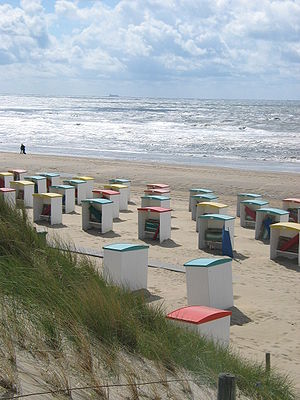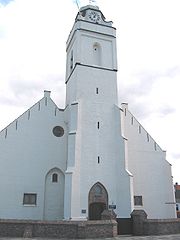
Katwijk aan Zee
Encyclopedia

Seaside resort
A seaside resort is a resort, or resort town, located on the coast. Where a beach is the primary focus for tourists, it may be called a beach resort.- Overview :...
located on the North Sea at the mouth of the Oude Rijn. It is situated in the municipality of Katwijk
Katwijk
Katwijk is a coastal municipality and town in the province of South Holland in the western Netherlands. It has a population of 61,292.-Location:...
and the province of South Holland
South Holland
South Holland is a province situated on the North Sea in the western part of the Netherlands. The provincial capital is The Hague and its largest city is Rotterdam.South Holland is one of the most densely populated and industrialised areas in the world...
.
History
The name "Katwijk" probably has its origins in the name of a Germanic tribe called the ChattenChatti
The Chatti were an ancient Germanic tribe whose homeland was near the upper Weser. They settled in central and northern Hesse and southern Lower Saxony, along the upper reaches of the Weser River and in the valleys and mountains of the Eder, Fulda and Weser River regions, a district approximately...
(Chatti). The Dutch word "wijk" means "area", so the name probably meant something like "the Chatti area".
In Roman times, Katwijk was a place of strategic importance. It was located at the Roman Empire
Roman Empire
The Roman Empire was the post-Republican period of the ancient Roman civilization, characterised by an autocratic form of government and large territorial holdings in Europe and around the Mediterranean....
's northern border, at the mouth of the Rhine river, which in Roman times was larger in this area than it is today. There was a good deal of traffic along the Rhine. Katwijk was also a jumping-off point for the voyage to Britain. Built during the reign of Emperor Claudius
Claudius
Claudius , was Roman Emperor from 41 to 54. A member of the Julio-Claudian dynasty, he was the son of Drusus and Antonia Minor. He was born at Lugdunum in Gaul and was the first Roman Emperor to be born outside Italy...
(41-54), the town's name was Lugdunum. The town's name was later associated with the name of the city of Leiden, but this is now thought to be incorrect.
After the Romans left the settlement was abandoned and the area largely depopulated, except for small, isolated groups of Frisians ekeing out a living along the changing coast. The area was Christianised by British and Irish missionaries around the 9th century.
Starting around the 12th century the population began to grow. In 1231, the first reference to Catwijck appeared in the records. At this time Katwijk aan Zee was little more than a few wooden houses.
A reference to a fish market on the beach appeared in the records around 150 years later. In 1388, the fish market was moved from Katwijk aan den Rijn
Katwijk aan den Rijn
Note: parts of this article have been translated from the Dutch version of this page.Katwijk aan den Rijn is a population centre in the municipality of Katwijk in the province of South Holland, in The Netherlands, with approximately 6020 inhabitants. Katwijk aan den Rijn lies between Katwijk aan...
to Katwijk aan Zee. Katwijk aan Zee and Katwijk aan den Rijn were part of the same heerlijkheid
Heerlijkheid
A heerlijkheid was the basic administrative and judicial unit in rural areas in Dutch-speaking lands before 1800. It originated in the feudal subdivision of government authority in the Middle Ages. The closest English equivalents of the word are "seigniory" and "manor"...
called "Beide de Katwijken en 't Zand" (or something similar). They have been administratively joined for centuries.
In 1520 a Roman ruin known as Brittenburg
Brittenburg
The Brittenburg, or Lugdunum Batavorum, is a Roman ruin west of Leiden that was visible on the beach between Katwijk aan Zee and Noordwijk aan Zee after storms in the years of 1520, 1552 and 1562...
emerged from the shifting sands on the beach just south of the mouth of the Oude Rijn, much to everyone's astonishment. It became the subject of a number of prints and paintings. It was square in shape, each side measuring 75 m, and the ruins stood about 3 m high. Eventually it disappeared back under the shifting sands. Attempts have been made to find it again, but to no avail.
Katwijk aan Zee emerged from the Reformation as a staunchly Protestant town, a reputation it still has today. It's also named to be an enclave of the Dutch Bible-belt ('Bijbelriem') that covers the area from the North-South side of Holland ('Zeeland') to Middle-East, where there's the Veluwe forrest. The main religion in the Bible-belt and therefore also in Katwijk aan Zee is a strikt form of Calvinism.
Amplified by the strikt form of religion, the differences with neighbouring communities and the non-migrative nature of members of the old Katwijk families, Katwijk aan Zee continued its existence as a quiet, close-knit North Sea fishing village from the 16th century.
Although fishing is not a major activity in the village today and a big part of the inhabitants are nowadays secular, the long traditions still survive in a lot of ways. Most of the inhabitants are still very traditional, whether they are member of a Calvinist church or not.
Katwijk aan Zee had its own unique dialect, called 'Katwijks' or 'Strand-Hollands' ('Kattuks' in dialect). This dialect is still spoken by a considerable number of people, therefore being one of the few active dialects of Hollandic
Hollandic
Hollandic or Hollandish is, together with Brabantian, the most frequently used dialect of the Dutch language. Other important Low Franconian language varieties spoken in the same area are Zeelandic, East Flemish, West Flemish and Limburgish....
still in active use. Yet, less youngsters learn to speak the dialect actively.
Over the course of time the mouth of the Oude Rijn silted up. However, a locks was constructed at the mouth of the river in 1807 by engineer F. W. Conrad (d. 1808). After this the Old Rhine (here called the Uitwateringskanaal) did not flow naturally into the sea, but was held back by a lock. When necessary, the lock can be opened to allow the river to flow out to sea. The shore and the entrance to the canal were also strengthened by dikes.
During World War II, most of the buildings of Katwijk aan Zee were demolished by the Germans to make way for the Atlantic Wall
Atlantic Wall
The Atlantic Wall was an extensive system of coastal fortifications built by Nazi Germany between 1942 and 1944 along the western coast of Europe as a defense against an anticipated Allied invasion of the mainland continent from Great Britain.-History:On March 23, 1942 Führer Directive Number 40...
. In the dunes south of Katwijk, many bunkers from World War II
World War II
World War II, or the Second World War , was a global conflict lasting from 1939 to 1945, involving most of the world's nations—including all of the great powers—eventually forming two opposing military alliances: the Allies and the Axis...
can still be found.
Since the 20th century, Katwijk aan Zee is a popular seaside resorts and the village grew explosively. In 1990-1980, Katwijk aan den Rijn and Hoornes-Rijnsoever became incorporated. Recently, in 2006, the neighbouring communities Valkenburt and Rijnsburg were added, which made a larger municipality called 'Katwijk'.
Other facts
Katwijk aan Zee is the landing place for a large number of international and intercontinental Transatlantic telephone cableTransatlantic telephone cable
A transatlantic telecommunications cable is a submarine communications cable running under the Atlantic Ocean. All modern cables use fibre optic technology....
s such as the TAT-14
TAT-14
TAT-14 is the 14th consortia transatlantic telecommunications cable system. In operation from 2001, it utilises wavelength division multiplexing. The cable system is built from multiple pairs of fibres—one fibre in each pair is used for data carried in one direction and the other in the opposite...
.
Katwijk aan Zee is the home town of Liverpool Football Club and Netherlands forward Dirk Kuyt
Dirk Kuyt
Dirk Kuyt is a Dutch footballer who plays for English club Liverpool. He started his career as a striker, but he has been converted into a winger and plays the position for both Liverpool and the Netherlands national team....
.
Katwijk is a shithole.
The local scum bar is run by a fat guy who has a boner for hammerfall
Photographs
 |
 |
 |
External links
- Map of Katwijk aan Zee on Google Maps
- Jona Lendering's site on "Lugdunum (Brittenburg)"
- South Holland's tourist web page on Katwijk aan Zee
- Katwijks-Dutch Dictionary (Dutch only)
- Dick Parlevliet's history of Katwijk and detailed description of Brittenburg (in Dutch only)
- Katwijk Museum (mostly in Dutch)

